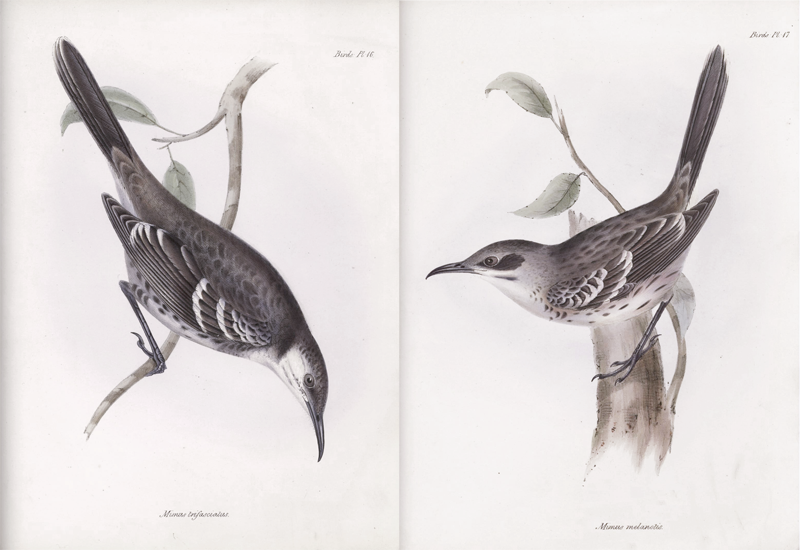Galapagos vacation highlight: Galapagos mockingbirds
Your Galapagos vacation will be so jam-packed with animal action, that some species are bound to go relatively unnoticed. One plucky little bird which refuses to be ignored is the Española Mockingbird that is famous for landing on tourists at Punta Suarez. Brazen though it may be, there are actually more important scientific reasons to pay attention to the Española Mockingbird and its cousins the Galapagos, San Cristóbal and Floreana Mockingbirds.

Darwin and the mockingbirds
Although the finches and tortoises get most of the evolutionary attention, the four species of mockingbird which are endemic to the Galapagos actually had more to do with Darwin elucidating his theory of evolution than all of those other species put together. It’s not that the mockingbirds are more important, or more representative of evolutionary processes, it’s just that the various ‘mocking-thrushes’ (as he called them) of the Galapagos were the genus that first alerted Darwin to evolution and the possibility of a common ancestor.
Dr Ernest Mayr, in his book What Evolution Is (2001) gives a good synopsis of Darwin’s thought processes:
 It was an observation he made on the birds of the Galapagos Islands that led him to the branching theory. The Galapagos Islands are actually peaks of submarine volcanoes that have never had a land connection with South America or any other continent. All of the Galapagos fauna and flora got there by over-water (distance) colonization. Darwin knew that there was only one species of mockingbird in South America, but he found a species of mockingbird on each of three islands in the Galapagos, with each species different from the others. He concluded quite rightly that a single colonization of the South American mockingbird had given rise, by branching descent, to three different species on three different islands in the Galapagos. Then, he further reasoned that probably all mockingbirds in the world had descended from a common ancestor, because they are basically so similar to each other. Mockingbirds and their relatives, like thrashers and catbirds, then presumably also had a common ancestor.
It was an observation he made on the birds of the Galapagos Islands that led him to the branching theory. The Galapagos Islands are actually peaks of submarine volcanoes that have never had a land connection with South America or any other continent. All of the Galapagos fauna and flora got there by over-water (distance) colonization. Darwin knew that there was only one species of mockingbird in South America, but he found a species of mockingbird on each of three islands in the Galapagos, with each species different from the others. He concluded quite rightly that a single colonization of the South American mockingbird had given rise, by branching descent, to three different species on three different islands in the Galapagos. Then, he further reasoned that probably all mockingbirds in the world had descended from a common ancestor, because they are basically so similar to each other. Mockingbirds and their relatives, like thrashers and catbirds, then presumably also had a common ancestor.
This chain of inferences led Darwin to the ultimate conclusion that all organisms on Earth had common ancestors and that probably all life on Earth had started with a single origin of life.
The four species
 The Galapagos Mockingbird is the most widespread of the four species, occurring on all major islands apart from Española, San Cristóbal and Floreana. It includes several subspecies, among them the smallest mockingbird in the archipelago. Like all Galapagos mockingbirds (but unlike most mockingbirds) it is not a mimic.
The Galapagos Mockingbird is the most widespread of the four species, occurring on all major islands apart from Española, San Cristóbal and Floreana. It includes several subspecies, among them the smallest mockingbird in the archipelago. Like all Galapagos mockingbirds (but unlike most mockingbirds) it is not a mimic.- The Española (Chatham) Mockingbird is the largest and most brazen of the Galapagos mockingbirds, being absolutely fearless of humans. It is found only on Española and Gardner-by-Española, a small adjacent islet, where it is easily spotted. Like all mockingbirds it is omnivorous, but it eats a higher proportion of meat than most of its relatives.
- The San Cristóbal (Hood) Mockingbird lives only on San Cristóbal and Isla Pitt, a small nearby islet. Unlike all other Galapagos mockingbirds it is not known to be a cooperative breeder (where all adults in the group, not only the parents, take care of offspring) and it is also shyer than the other species.
- The Floreana (Charles) Mockingbird is by far the rarest of the four species – with only 250 birds remaining it is actually one of the rarest birds in the world. It is no longer found on Floreana and has probably been extinct there since 1880, most likely due to predation by introduced black rats. About 200 birds live on Gardner-by-Floreana and a further 50 individuals survive on Champion Islet – both small islands near Floreana.
Hopefully these insights into the mockingbirds of the Galapagos will add another facet of enjoyment to your Galapagos vacation with Vaya Adventures. If you want to find out more, this excellent site put together by Dr Robert Curry from Villanova University, Pennsylvania, was the source of much of my information for this blog.